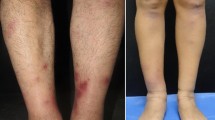Abstract
The mechanism of idiosyncratic drug reactions (IDRs) remains poorly understood. D-penicillamine treatment is associated with a wide range of autoimmune reactions including liver injury. An animal model which utilizes brown Norway (BN) rats has been used to investigate the mechanism of D-penicillamine-induced IDRs because it mimics the autoimmune reactions that occur in humans. The purpose of this study was to investigate the type of liver injury that results from D-penicillamine treatment in BN rats. We had previously noted that D-penicillamine caused histological changes in the liver, but there was no increase in alanine transaminase (ALT), and we assumed that there was no significant injury. However, we subsequently discovered that D-penicillamine inhibits the ALT assay. In the present study, we found that treatment of BN rats with a low doses of D-penicillamine (10 or 15 mg/day) resulted in a mild increases in glutamate dehydrogenase (GLDH) and sorbitol dehydrogenase (SDH) activities; however, this was not associated with histological changes. A higher dose of D-penicillamine (20 mg/day) resulted in 63 % of the rats developing a skin rash, and these rats had elevated serum GLDH and SDH levels with histopathological changes characteristic of granulomatous hepatitis. This included large clusters of leukocytes in the form of granulomas that contained neutrophils, macrophages, and CD8 T cells. These changes did not occur in the rats that did not get sick. This model may be a good model to investigate the characteristics of drug-induced granulomatous hepatitis.





Similar content being viewed by others
References
Ishak R, Abbas O (2013) Penicillamine revisited: historic overview and review of the clinical uses and cutaneous adverse effects. Am J Clin Dermatol 14:223–233
Donker AJ, Venuto RC, Vladutiu AO, Brentjens JR, Andres GA (1984) Effects of prolonged administration of D-penicillamine or captopril in various strains of rats. Brown Norway rats treated with D-penicillamine develop autoantibodies, circulating immune complexes, and disseminated intravascular coagulation. Clin Immunol Immunopathol 30:142–155
Zhu X, Li J, Liu F, Uetrecht JP (2011) Involvement of T helper 17 cells in D-penicillamine-induced autoimmune disease in brown Norway rats. Toxicol Sci 120:331–338
Uetrecht J, Naisbitt DJ (2013) Idiosyncratic adverse drug reactions: current concepts. Pharmacol Rev 65:779–808
Uetrecht J (2009) Immunoallergic drug-induced liver injury in humans. Semin Liver Dis 29:383–392
Seguin B, Teranishi M, Uetrecht JP (2003) Modulation of D-penicillamine-induced autoimmunity in the brown Norway rat using pharmacological agents that interfere with arachidonic acid metabolism or synthesis of inducible nitric oxide synthase. Toxicology 190:267–278
Li J, Uetrecht JP (2009) D-penicillamine-induced autoimmunity: relationship to macrophage activation. Chem Res Toxicol 22:1526–1533
Rosenbaum J, Katz WA, Schumacher HR (1980) Hepatotoxicity associated with use of D-penicillamine in rheumatoid arthritis. Ann Rheum Dis 39:152–154
Jacobs JW, Van der Weide FR, Kruijsen MW (1994) Fatal cholestatic hepatitis caused by D-penicillamine. Br J Rheumatol 33:770–773
Metushi IG, Nakagawa T, Uetrecht J (2012) Direct oxidation and covalent binding of isoniazid to rodent liver and human hepatic microsomes: humans are more like mice than rats. Chem Res Toxicol 25:2567–2576
Metushi IG, Uetrecht J (2013) Isoniazid-induced liver injury and immune response in mice. J Immunotoxicol 0:1–10
Metushi IG, Uetrecht J (2013) Lack of liver injury in Wistar rats treated with the combination of isoniazid and rifampicin. Mol Cell Biochem 387:9–17
Laskin DL (2009) Macrophages and inflammatory mediators in chemical toxicity: a battle of forces. Chem Res Toxicol 22:1376–1385
Guidotti LG, Iannacone M (2013) Effector CD8 T cell trafficking within the liver. Mol Immunol 55:94–99
Ishihara S, Nieda M, Kitayama J, Osada T, Yabe T, Ishikawa Y, Nagawa H, Muto T, Juji T (1999) CD8(+)NKR-P1A (+)T cells preferentially accumulate in human liver. Eur J Immunol 29:2406–2413
Iiai T, Watanabe H, Suda T, Okamoto H, Abo T, Hatakeyama K (2002) CD161 + T (NT) cells exist predominantly in human intestinal epithelium as well as in liver. Clin Exp Immunol 129:92–98
Uetrecht J (2005) Current trends in drug-induced autoimmunity. Autoimmun Rev 4:309–314
Gong Y, Klingenberg SL, Gluud C (2006) Systematic review and meta-analysis: D-Penicillamine vs. placebo/no intervention in patients with primary biliary cirrhosis–Cochrane Hepato-Biliary group. Aliment Pharmacol Ther 24:1535–1544
Iorio R, D’Ambrosi M, Marcellini M, Barbera C, Maggiore G, Zancan L, Giacchino R, Vajro P, Marazzi MG, Francavilla R, Michielutti F, Resti M, Frediani T, Pastore M, Mazzarella G, Fusco G, Cirillo F, Vegnente A (2004) Serum transaminases in children with Wilson’s disease. J Pediatr Gastroenterol Nutr 39:331–336
Watkins PB (2005) Idiosyncratic liver injury: challenges and approaches. Toxicol Pathol 33:1–5
Ng W, Metushi IG, Uetrecht J (2013) Hepatic effects of aminoglutethimide: a model aromatic amine. J Immunotoxicol 0:1–9
Rodes J, Benhamou J-P, Blei AT, Reichen J, Rizzetto M (2007) Textbook of hepatology: from basic science to clinical practice, 3rd edn. Blackwell Publishing, London, p 1096
Bowen DG, McCaughan GW, Bertolino P (2005) Intrahepatic immunity: a tale of two sites? Trends Immunol 26:512–517
Author information
Authors and Affiliations
Corresponding author
Additional information
Imir G. Metushi and Xu Zhu have contributed equally to this manuscript.
Electronic supplementary material
Below is the link to the electronic supplementary material.
Rights and permissions
About this article
Cite this article
Metushi, I.G., Zhu, X. & Uetrecht, J. D-penicillamine-induced granulomatous hepatitis in brown Norway rats. Mol Cell Biochem 393, 229–235 (2014). https://doi.org/10.1007/s11010-014-2065-8
Received:
Accepted:
Published:
Issue Date:
DOI: https://doi.org/10.1007/s11010-014-2065-8




